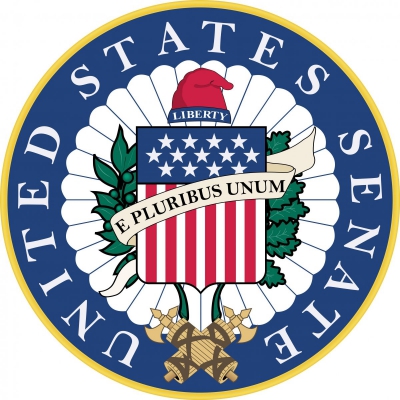The Louisiana Purchase (French: Vente de la Louisiane, lit.'Sale of Louisiana') was the acquisition of the territory of Louisiana by the United States from the French First Republic in 1803. In return for fifteen million dollars, or approximately eighteen dollars per square mile, the United States nominally acquired a total of 828,000 sq mi (2,140,000 km2; 530,000,000 acres). However, France only controlled a small fraction of this area, most of which was inhabited by Native Americans; effectively, for the majority of the area, the United States bought the "preemptive" right to obtain "Indian" lands by treaty or by conquest, to the exclusion of other colonial powers.The Kingdom of France had controlled the Louisiana territory from 1699 until it was ceded to Spain in 1762. In 1800, Napoleon, the First Consul of the French Republic, regained ownership of Louisiana as part of a broader effort to re-establish a French colonial empire in North America. However, France's failure to suppress a revolt in Saint-Domingue, coupled with the prospect of renewed warfare with the United Kingdom, prompted Napoleon to consider selling Louisiana to the United States. Acquisition of Louisiana was a long-term goal of President Thomas Jefferson, who was especially eager to gain control of the crucial Mississippi River port of New Orleans. Jefferson tasked James Monroe and Robert R. Livingston with purchasing New Orleans. Negotiating with French Treasury Minister Franois Barb-Marbois, the American representatives quickly agreed to purchase the entire territory of Louisiana after it was offered. Overcoming the opposition of the Federalist Party, Jefferson and Secretary of State James Madison persuaded Congress to ratify and fund the Louisiana Purchase.
The Louisiana Purchase extended United States sovereignty across the Mississippi River, nearly doubling the nominal size of the country. The purchase included land from fifteen present U.S. states and two Canadian provinces, including the entirety of Arkansas, Missouri, Iowa, Oklahoma, Kansas, and Nebraska; large portions of North Dakota and South Dakota; the area of Montana, Wyoming, and Colorado east of the Continental Divide; the portion of Minnesota west of the Mississippi River; the northeastern section of New Mexico; northern portions of Texas; New Orleans and the portions of the present state of Louisiana west of the Mississippi River; and small portions of land within Alberta and Saskatchewan. At the time of the purchase, the territory of Louisiana's non-native population was around 60,000 inhabitants, of whom half were enslaved Africans. The western borders of the purchase were later settled by the 1819 AdamsOns Treaty with Spain, while the northern borders of the purchase were adjusted by the Treaty of 1818 with Britain.
The United States Senate is the upper chamber of the United States Congress, with the House of Representatives being the lower chamber. Together they compose the national bicameral legislature of the United States.
The composition and powers of the Senate are established by Article One of the United States Constitution. The Senate is composed of senators, each of whom represents a single state in its entirety. Each state is equally represented by two senators who serve staggered terms of six years. There are currently 100 senators representing the 50 states. The vice president of the United States serves as presiding officer and president of the Senate by virtue of that office, and has a vote only if the senators are equally divided. In the vice president's absence, the president pro tempore, who is traditionally the senior member of the party holding a majority of seats, presides over the Senate.
As the upper chamber of Congress, the Senate has several powers of advice and consent which are unique to it. These include the approval of treaties, and the confirmation of Cabinet secretaries, federal judges (including Federal Supreme Court justices), flag officers, regulatory officials, ambassadors, other federal executive officials and federal uniformed officers. If no candidate receives a majority of electors for vice president, the duty falls to the Senate to elect one of the top two recipients of electors for that office. The Senate conducts trials of those impeached by the House.
The Senate is widely considered both a more deliberative and more prestigious body than the House of Representatives due to its longer terms, smaller size, and statewide constituencies, which historically led to a more collegial and less partisan atmosphere.From 1789 to 1913, senators were appointed by legislatures of the states they represented. They are now elected by popular vote following the ratification of the Seventeenth Amendment in 1913. In the early 1920s, the practice of majority and minority parties electing their floor leaders began. The Senate's legislative and executive business is managed and scheduled by the Senate majority leader.
The Senate chamber is located in the north wing of the Capitol Building in Washington, D.C.

1803Oct, 20
The United States Senate ratifies the Louisiana Purchase.
Choose Another Date
Events on 1803
- 18May
Treaty of Amiens
Napoleonic Wars: The United Kingdom revokes the Treaty of Amiens and declares war on France. - 23Sep
Battle of Assaye
Second Anglo-Maratha War: Battle of Assaye between the British East India Company and the Maratha Empire in India. - 20Oct
Louisiana Purchase
The United States Senate ratifies the Louisiana Purchase.

 English
English  español
español  français
français  português
português  русский
русский  العربية
العربية  简体中文
简体中文 